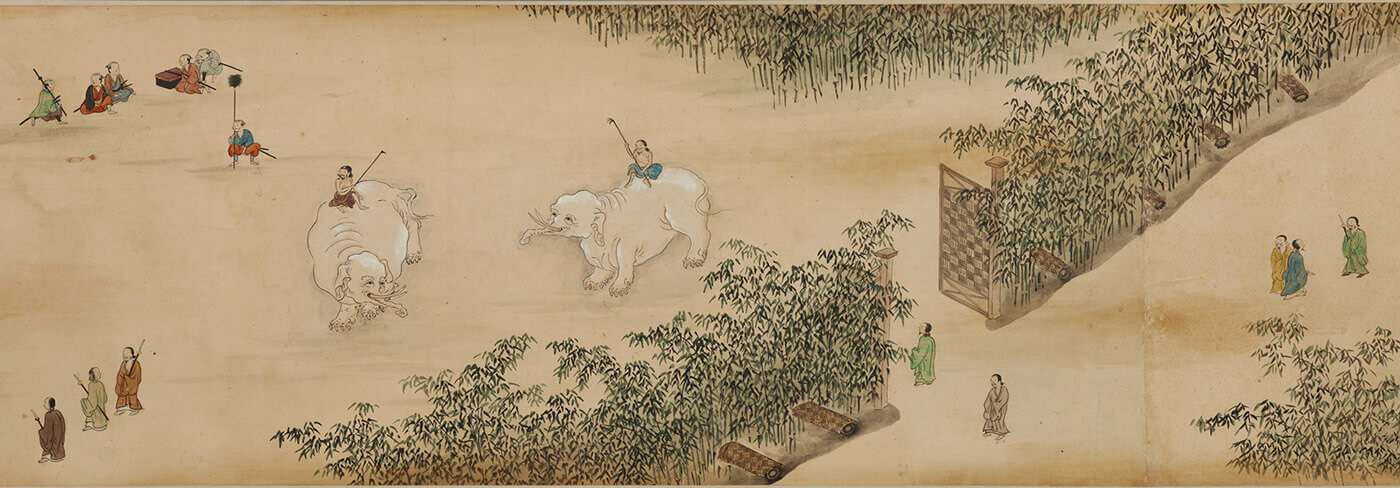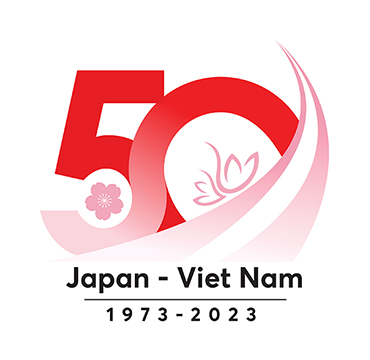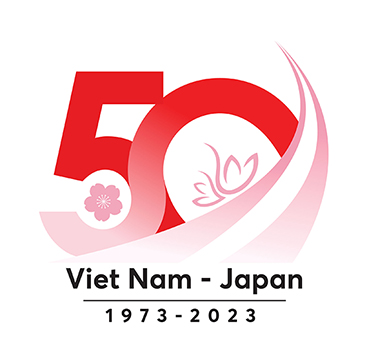Act I
Scene One: Raging Sea
Characters: Sotaro, Hachibei, Yasuke, and other sailors
Scene: The Red Seal ship sailing on a stormy sea and the crew's desperate struggle to survive.
Overture: Introduces the life of Araki Sotaro and Princess Anio, trying to overcome the difficulties they face in the rough seas.
The story begins when Araki Sotaro was 22 years old. He and his crew were caught in a big storm on their way to Dang Trong in the South China Sea. Although a young captain, he managed to weather the storm and then found another ship adrift in the sea. He ordered his crew to rescue the people onboard.
Scene Two: Encounter
Characters: Sotaro, Yasuke, Princess Anio, Potato, Sticky Rice, Winter melon
Scene: Inside the cabin of Araki Ship, he meets Princess Anio for the first time.
Quartet of Encounter
Aboard the shipwreck were four children, all around ten years or younger. Sotaro offers the frightened children warm porridge and tries to speak in what little Dang Trong words he knows to comfort them. Potato, a boy with a big appetite, couldn't contain his hunger and made a big mess as he rushed to eat the porridge. However, Sotaro's gentle demeanor and interaction with Potato's clumsiness actually helped to ease the tension among the children.
One of the children, Princess Anio, learned Sotaro's name, and he taught her the Japanese word, arigatou, to express her gratitude. The scene portrays the heartwarming interaction between Sotaro and the children.

Act II
Scene One: The King's True Feelings
Characters: King Nguyen, Minister
Scene: A stage without a set. Ten years after Act 1. Two figures emerge from the spotlight.
Aria from Conflict, King Nguyen
Dialogue of King Nguyen with the minister
"Your Majesty, have you reached a decision on this matter yet?" The minister's tone is insistent, pressing King Nguyen for an answer.
"I am aware of my duty." King Nguyen's response is measured, but his hesitation is evident as he grapples with conflicting emotions as a father and king.
Scene Two: The Bustling City
Characters: Sotaro, Interpreter, Soldiers, Dockworkers, Townspeople Children, Fortune Teller, Dutchman, etc.
Scene: Ten years after Act 1. At the port near the Japanese town of Hoi An, Sotaro supervises the unloading of shipments.
Sotaro is engaged in a discussion about the nature of his business with an interpreter. They talk enthusiastically about how their countries can enrich each other through trading fragrant woods, dyes, sugar, copper coins, pottery, swords, and other specialties. As they delve into the details of their trade, several of King Nguyen's soldiers appear, seeking Sotaro's expertise in swordsmanship. The captain pleads with Sotaro to teach him how to use a Japanese sword. As it was a long-standing promise between the two, Sotaro obliges and wields one of the swords from the shipment set to be sold. He demonstrates the art of Japanese swordsmanship, imparting his knowledge to the captain. Impressed by his prowess and skill, the bystanders erupted in loud cheers. Just as the excitement reaches its peak, a voice from the outskirts of the port town cries out in a panic, "It's a disaster! An elephant is running amok!" (Transitions into Scene Three)
Scene Three: The Rampaging Elephant
Characters: Sotaro, Fortune Teller, Child, Townspeople passersby
Scene: The stage remains dark. The scene of the elephant running amok on the dock is narrated by puppets.
A herd of war elephants marches into formation near the port. An apprentice handler causes one of the elephants to go berserk, and the town is thrown into chaos. The port is wrecked, and a fortune teller and a child find themselves paralyzed with fear, unable to move as the elephant continues its rampage. "Watch out!" Sotaro jumps to the rescue, but the elephant throws him down, leaving him vulnerable of being trampled. Just as the elephant was about to strike, a beautiful melody echoed through the air, coming from a flute played by none other than Princess Anio. As if in a trance, the elephant stops in its tracks and calms down.

Scene Four: The Reunion
Characters: Princess Anio, Sotaro, Interpreter, Fortune Teller, a Child, and the Townspeople
Scene: The puppets show Sotaro about to be attacked by the elephant. The scene begins with Princess Anio appearing in a spotlight from offstage.
After the crisis, Princess Anio helps the fallen fortune teller and holds her in her arms. Sotaro, who narrowly escaped death thanks to Princess Anio, is captivated by her. He thanks Princess Anio for saving his life. He utters the word, arigatou, triggering a flood of memories from a decade ago. Sotaro offers to escort Princess Anio home in a boat. From there, the two realize that their first encounter was a serendipitous moment that paved the way for their reunion. As they embrace this unexpected twist of fate, they fall in love with each other.
Scene Five: The King's True Feelings, Part Two
Characters: King Nguyen, Minister, and Princess Anio
Scene: At the king's chamber.
As the time for Princess Anio's arranged marriage draws near, the minister pressures King Nguyen to decide on his daughter's fate. Torn between his roles as a king and a father, he finally speaks up with resolve, "Should the princess so desires, then so be it."
The king opposed to the marriage awaits Princess Anio's response with bated breath. "Princess, are you certain you are prepared to follow a sailor into an unfamiliar, distant land?"
Princess Anio responds, "Indeed, Father, I am fully prepared to journey to Japan. I love Sotaro dearly."
The king and the minister are astonished at the resolute response from the princess. Her unwavering determination, and the queen's heartfelt words of compassion, ultimately convince King Nguyen to grant permission for the couple to wed and embark on their journey to Japan.
Scene Six: The Wedding Ceremony
- Characters:
- King Nguyen, Queen, Princess Anio, Sticky Rice, Potato, Sotaro, other Courtiers, Citizens, Sailors, etc.
Scene: A banquet hall in the royal palace holds the wedding ceremony.
Celebratory Chorus, King Nguyen, and the rest of the cast in the banquet
The wedding ceremony begins with a proclamation from the King, and the banquet hall erupts into a joyous chorus of celebration. The queen offers wisdom to her beloved daughter, "Be dignified, follow your heart, and enjoy life wherever you go." She presents her daughter with an intricate mirror as a wedding gift, entrusting her care to attendants accompanying her to Japan. Amidst the grand festivities, the scene shifts from the royal palace to the deck of Araki Ship bound for Nagasaki. The voyage from Dang Trong to Nagasaki is filled with anticipation. Yet it also brims with excitement for what lies ahead.

Act III
Scene One: A Happy Nagasaki Life
Characters: Sotaro, Princess Anio, Yasu (their baby), Potato, Winter Melon, Sticky Rice, Nagasaki Townspeople
Scene: The port of Nagasaki, Japan - a town full of merchants
Aria, Ichigenkin (Japanese single-stringed zither), Princess Anio
Chorus, Japanese Lullaby, Townspeople (Princess Anio joins in the last few bars.)
As Princess Anio and Sotaro stroll through the town, the townspeople warmly greet them. The whole family and the locals joyfully sing together as they go about their daily lives and interactions. Princess Anio sings and plays an aria on her harp at the request of the locals, filling the air with a nostalgic melody and captivating the hearts of the people. She also asks the locals to teach her Japanese lullabies for her newborn daughter, Yasu. The townspeople became fond of the family, grateful for the moments of warmth and happiness they brought to their lives.
Scene Two: A Notice of National Isolation Law
Characters: Sotaro, Nagasaki Magistrate, Princess Anio, Yasu
Scene: The port of Nagasaki, Japan, just before the national isolation.
Aria of Notice of National Isolation, Nagasaki Magistrate
Aria of Despair, Sotaro
One day, Sotaro receives a letter from the Nagasaki magistrate informing him that Japan will undergo national isolation and be closed from trading with the rest of the world. Sotaro and the magistrate discuss the new law's repercussions, leaving Sotaro distraught.. The magistrate empathizes with Sotaro, but his hands are tied. As despair crushes Sotaro's heart, he remembers his promises to the king and queen of Dang Trong, his love for the sea, and Princess Anio.
Princess Anio hears of the terrible news and rushes to her husband. The two embrace, seeking comfort from the hardships that lie ahead. The scene ends with Yasu running to them.

Act IV
Scene One: Farewell to Sotaro
Characters: Princess Anio, Sotaro
Scene: In Princess Anio's dream.
Aria, Anh Oi, Princess Anio
Sotaro and Princess Anio walk happily through the town. Princess Anio, as always, talked animatedly with Sotaro, noticing the changes in town and the beautiful scenery. Suddenly, Sotaro slowly steps away, his expression somber.
In her dream, she recalls the pain and emptiness she felt when Sotaro passed away. She vividly remembers the day they received the devastating news of Japan's national isolation policy as well. Overwhelmed with emotion, she pours her heart out to Sotaro, expressing her gratitude for his love and support.
Princess Anio calls out to Sotaro in Dang Trong dialect, saying "Anh Oi," and starts singing. Sotaro reappears, comforting the grieving princess and encouraging her to find strength in their love and to look toward the future with hope. Princess Anio finds solace in the precious moments she shared with Sotaro. Filled with renewed determination, she vowed to honor Sotaro's memory by living her life to the fullest.
Scene Two: Memories of a Mother, Princess Anio
Characters: Princess Anio, Yasu
Scene: In front of Sotaro's grave. Yasu appears to Princess Anio while visiting the grave.
Duet, Memories of Princess Anio, Princess Anio and Yasu
Yasu stands in quiet reflection as memories of her mother, Princess Anio, her father, Sotaro, her mother's hometown, and the happy moments she shared with the people of Nagasaki through the years crossed her mind. As her thoughts wander, as if fate read her mind and responded to her thoughts, Princess Anio collapsed.
Scene Three: Finale - Towards a Bright Future
Characters: Princess Anio, Yasu, Nagasaki Magistrate, Potato, Winter Melon, Sticky Rice, Sotaro, King Nguyen, Queen, Townspeople
Scene: Princess Anio's bedroom in the Araki household.
Duet, Arigatou, Princess Anio and Yasu
Chorus, Miracle, The Whole Cast
Princess Anio is on her bed with her daughter, Yasu, and the townspeople.
In her final moments, she entrusts Yasu with the hairpin that Sotaro gave her and the mirror from her mother, the queen. She recounts her first encounter with Sotaro to Yasu, how their fate guided them to find each other again through a single word - arigatou - before taking her last breath. Inspired and driven by her parents' story, Yasu tells the townspeople, "Let us hold a festival in honor of their love so that their story can stand the test of time until the day they can freely travel to their beloved hometowns again. The magistrate, along with the townspeople, agrees, and sings in unison.
At the end, the whole cast joins the chorus, Sotaro, Princess Anio, the king, the queen, etc., and in between reality and fiction, the scene reaches its end with a curtain call-like splendor, concluding with a grand finale.

References
- Kadoya Kankei Monjoshu (角屋関係文書集) (1958) Edited by Jingu Museum
- Nanyo Nihon-machi no Kenkyu (南洋日本町の研究) (1966) by Iwao, Seiichi. Publisher: Iwanami Shoten
- Kingendai no Tonan Asia (近現代の東南アジア) (1991) by Wada, Masahiko. Publisher: NHK Publishing, Inc.
- Umi no Silk Road to Vietnam (海のシルクロードとベトナム) (1993) Edited by Japan Society for Vietnamese Studies. Publisher: HOTAKA BOOK CO., LTD.
- Vietnam Hoi An Machinami Hozon Chosa Houkokusho (ベトナム・ホイアン町並み保存調査報告書) (1997) Edited by Fukukawa, Yuichi. Publisher: Showa Women's University Institute of International Culture
- Vietnam Hoi An Koukogaku Chosa Houkokusho (ベトナム・ホイアン考古学調査報告書) (1998) Edited by Kikuchi, Seiichi. Publisher: Showa Women's University Institute of International Culture
- Tonan Asia Shi #1 Tairiku-bu (東南アジア史①大陸部) (1999) Edited by Ishi, Yoneo and Sakurai, Yumio. Publisher: Yamakawa Shuppansha
- Kinsei Nichi-Etsu Kouryushi (近世日越交流史) (2002) Edited by Sakurai, Kiyohiko and Kikuchi, Seiichi. Publisher: KASHIWASHOBO Publishing Co.,Ltd.
- Vietnam Nihon-machi no Koukogaku (ベトナム日本町の考古学) (2003) Edited by Kikuchi, Seiichi. Publisher: Koshi Shoin
- Vietnam Machinami Kanko Guide (ベトナム町並み観光ガイド) (2003) Edited by Tomoda, Hiromichi. Publisher: Iwanami Shoten
- Umi no Michi to Koukogaku - Indochine Hantou kara Nihon e (海の道と考古学―インドシナ半島から日本へ) (2010) Edited by Kikuchi, Seiichi and Abe, Yuriko. Publisher: Koshi Shoin
- Shuinsen Boueki Ezu no Kenkyu (朱印船貿易絵図の研究) (2014) Edited by Kikuchi, Seiichi. Publisher: SHIBUNKAKU CO., LTD.
- Vietnam Monogatari (ベトナム物語) The Great Story of Vietnam - Official Pamphlet (2013) Edited by the Kyushu National Museum
- Những Người Châu Âu ở Nước An Nam (2016) by Charles B. Maybon, translated by Nguyễn, Thừa Hỷ. Publisher: Nhà Xuất Bản Thế Giới
- Xã Hội Việt Nam qua Bút Ký của Người Nước Ngoài (2017) by Lê Nguyễn. Publisher: Nhà Xuất Bản Hồng Đức
- Vietnam Hoi An Koukogaku Chosa Houkokusho (ベトナム・ホイアン考古学調査報告書) (2020) Edited by Kikuchi, Seiichi and Kikuchi, Yuriko. Publisher: Showa Women's University Institute of International Culture
- Wagana wa Araki Sotaro (わが名は荒木宗太郎) by Iwasaki, Kyoko, illustration by Nagano, Hideko. Publisher: KAISEI-SHA Ltd.
- Ikoku no Hata (異国の旗) by Shiraishi, Ichiro. Publisher: Chuokoron-Sha
Information provided by
*Listed in alphabetical order
Jomyoji Temple, Nagoya
Kumata Shrine, Osaka
Kyushu National Museum
Museum of Maritime Science
Nagasaki Museum of History and Culture
National Archives of Japan, Digital Archive
Osaka Prefectural Nakanoshima Library
Sakai City Museum






